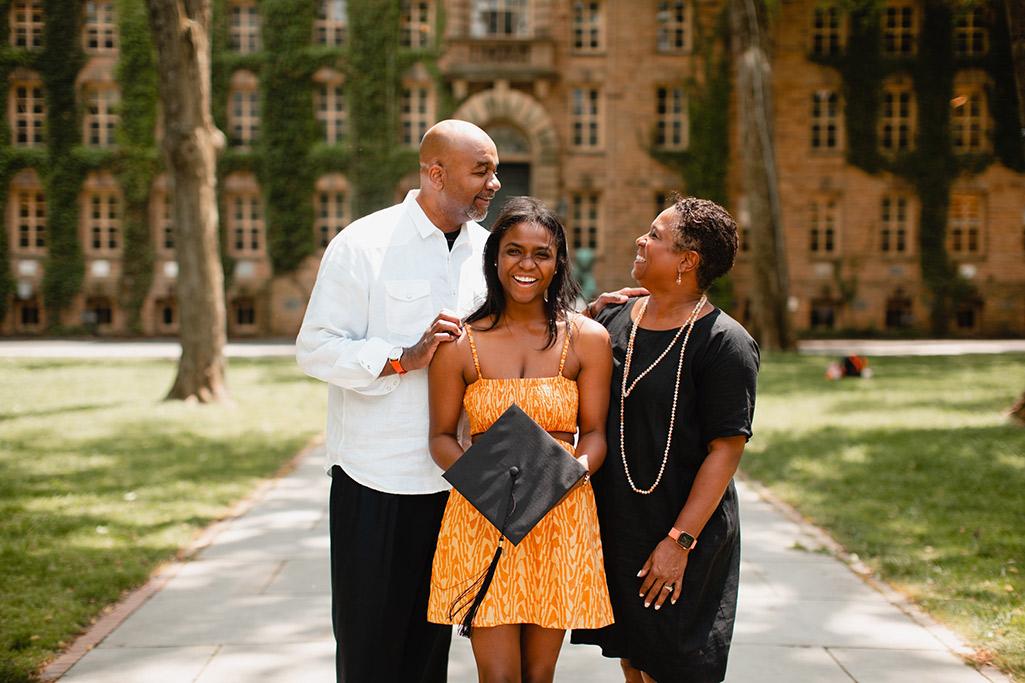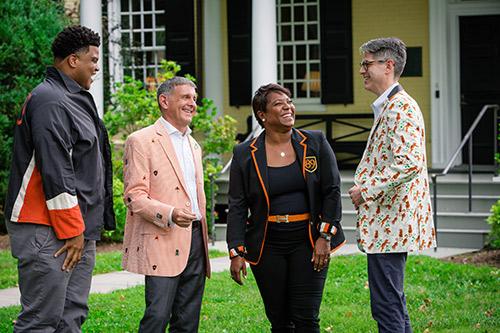Monica Moore Thompson ’89: ‘There’s unity to be found in the orange and black’

Photo by Andrea Kane
“I love how when we look back at our lives, things we think are just happenstance are really dots connecting to a greater picture that becomes clearer as time moves forward.”
For Monica Moore Thompson ’89, president of the Alumni Association and chair of the Alumni Council, those words resonate. She grew up in Highland Park, New Jersey — near Rutgers University — and when she was deciding between Princeton and Georgetown, a friend connected her with a first-year Princeton student whose father worked at Georgetown. His name was John Thompson III ’88. Monica chose Princeton, she and John remained friendly as undergraduates and began dating after graduation, marrying in 1997. John coached men’s basketball at both Princeton and Georgetown, Monica spent several years in what is now the Princeton Advancement office and became an alumni leader, and one of their three children — daughter Morgan — graduated from Princeton in 2020.
In addition to the six years she worked in Princeton Advancement, Thompson served as an officer of the Association of Black Princeton Alumni, worked on the steering committee of the Connect Initiative, was a longstanding volunteer for the Class of 1989’s Annual Giving campaigns, and chaired the Committee to Nominate Alumni Trustees (CTNAT) before partnering with Mary Newburn ’97 as vice president of the Alumni Association and vice chair of the Alumni Council in 2021. She brings all that experience and perspective to her new leadership roles.
“Now more than ever, it’s really important to focus on what brings us together,” Thompson said. “Mary was an incredible leader, and she did an excellent job of creating an Alumni Council that was welcoming to everyone. My hope is to build upon that.”
Thompson now lives in McLean, Virginia, and even when she travels, Princeton never seems far away because of the devotion that binds Princeton alumni. “Recently in Hydra, Greece, we were walking through town, and noticed a man wearing a Princeton hat,” she said. “We immediately engaged in conversation, and took a picture together. In addition, we had dinner with one of John’s teammates and his wife, who happened to be on vacation in Greece as well. Princeton alumni love to connect, and this University has traditions and structures in place that help foster those bonds beyond our time as students and for the rest of our lives.”
Thompson recently shared her hopes for leading the alumni community forward and how connecting the dots of her Princeton experience came into focus.
As a high school student, what did Princeton represent to you as a place and an idea?
My parents were both educators, and I grew up in a household that valued education. My father taught at Princeton High School and my initial Princeton experience was strolling along Nassau Street as a child. Even before I fully understood the University’s prestige, I developed a fond appreciation for the beauty of the campus and the town. Communiversity, the artfest celebrating town and gown, was a memorable event growing up. Princeton represented excellence in academics, a stunning campus, in addition to fond childhood memories for me. Years later when I applied to college, Princeton was at the top of my list.
Were there certain things that surprised you about Princeton once you were here as a student?
Princeton had a larger international outreach than I realized. International students enhanced the campus experience and offered a vibrant diversity of viewpoints and cultures. Having a global campus enriched the educational experience for all of us, promoting cross-cultural understanding and a global awareness. I loved that aspect of my Princeton experience.
Was there a certain Princeton class or professor that, in hindsight, you can point to as a pivot point in your academic or professional development?
I declared history as my major because of the excellent teaching and captivating professors in the department. Two of the most memorable and influential to me were Professor Stanley Stein, who taught Latin American history, and Professor Anthony Grafton, who still teaches European history. Another memorable professor was Valerie Smith, who taught an incredible course on the literature of African American women. This class had a remarkable syllabus and I still have some of those books, which are very worn. Each time we move to a new house and I go through my bookshelf to see what I can get rid of while I’m packing, I hold onto those books because of fond memories from Professor Smith’s class.
Current students might not be aware of the extent of the support and passion that Princeton’s alumni community provides now and for the rest of their lives. When you look back at your transition from undergraduate into alumni, what was your first toe in the water of the alumni community?
After graduating from Princeton, I had a fellowship working at the Smithsonian National Museum of American History. I volunteered to interview applicants in Washington, D.C., for the Alumni Schools Committee. In addition, PC Pitts ’79 reached out to me personally and invited me to attend an Association of Black Princeton Alumni (ABPA) meeting. That’s how I connected with the Princeton alumni in my area. So fast forward: as chair of the Alumni Council, one of the ad hoc committees that we’ve developed is a committee called Alumni Volunteer Pathways. That committee will be co-chaired by PC along with Ted Stephens ’95. They will communicate pathways to recruit and develop future alumni volunteers. How do we encourage alumni to engage with their communities, with one another and with the University? How do we make volunteer opportunities clear and accessible to all alumni, whatever their life stage?
That sounds like a theme for your leadership of the Alumni Council.
I view our Alumni Council as a group of individuals who create a rich tapestry of backgrounds, experiences and opinions, united by our passion for Princeton. It is through this shared community that we celebrate and foster connections. I think it’s really important that all Princeton alumni feel that they have a place to connect and to become engaged, if they so desire. To sustain the level of engagement that makes Princeton exemplary, I hope that all graduating students feel like there’s a place for them as alumni. The strength of our bond is our shared identity as Princeton alumni and the wonderful traditions that bring us together. There’s unity to be found in the orange and black. I am Princeton, you are Princeton. Together, we are Princeton.

Over the years, you’ve worn many hats as a Princeton alumni leader. Do certain experiences stand out?
When I worked at Princeton from 1998 to 2004, the University initiated affinity conferences to engage a broader alumni population. I helped in the planning stage by organizing focus groups around the country to guide us in developing the conferences. These initial events were wildly successful and demonstrated that our alumni enjoy connecting by shared identities. Since then, the conferences have expanded, more alumni have reconnected to Princeton and new volunteer leaders have emerged. In 2021, I served on University Advancement’s task force on Affinity Programming to set guiding principles on how to support the initiative into the future. Serving on and chairing the Committee to Nominate Alumni Trustees was another highlight in my alumni service to Princeton. I learned so much about the characteristics of good leadership and building strong, balanced groups.
Your husband is a basketball coach, so forgive me for asking if you’ve absorbed some of his philosophy for putting together a great team.

What I’ve loved most about this work as an alumni volunteer is that it has provided me with an opportunity to meet Princetonians who I may never have met. Even Mary Newburn — our paths never crossed before working together in the Alumni Council. When you’re building a team, it’s important to have different perspectives and talents around the table. I hate to use a basketball analogy, but if a team consists of all centers and no guards, that can make it hard to be effective. We want to make sure that we have the equivalent of shooters, rebounders and defenders; volunteers that can complement one another to make us the strongest team that we can be. I’m so happy to have Ryan Ruskin ’90 as vice chair. He and I got to know each other through our work on CTNAT, and he brings just incredible insight and creativity to the work. In addition to Ryan, our Alumni Council officer team includes Adam Lichtenstein ’95 *10, who is treasurer now after serving as assistant treasurer for the last two years, and it’s wonderful to add Eric Plummer ’10, who has done an amazing job of leading ABPA.
If we were to chat again like this in two years, what is the challenge that would make you the proudest to say you successfully met?
When I look at the last few years, I think the biggest challenge is making sure that the students who have been on campus during a time when our country has been fraught with difficulties — the pandemic, social justice concerns, the polarizing political climate of our country right now — are able to come through this snapshot in time and find a meaningful way to connect and engage as Princeton alumni. Afterall, we are students for a few years, but our alumni journey is lifelong.


